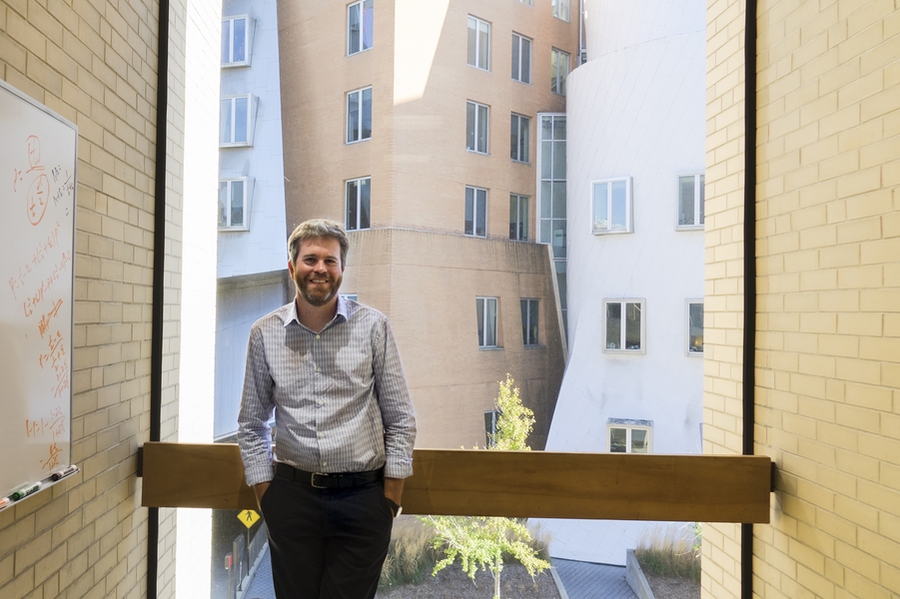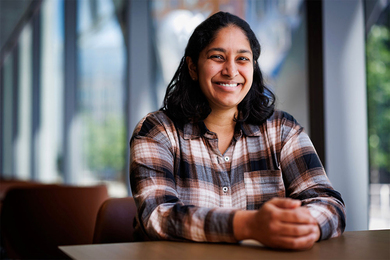When plants are faced with stressful conditions, such as droughts or changes in climate, they must adapt to their environment in order to survive. But how exactly does this adaptation occur? How can these processes be used to inform how scientists improve agriculture?
David Des Marais, who recently joined the Department of Civil and Environmental Engineering (CEE) as an assistant professor, seeks to find answers to such questions through his research on plant physiology and their genetic processes.
“Plants, whether they are in an agricultural field or in a forest, are receiving so many cues, every minute, every hour, and every day. They’re receiving cues about light, temperature, water availability, what’s in the soil, what kids of pathogens and herbivores there are, and so on,” Des Marais says. “So when you want to understand how plants respond to certain cues, it’s really hard to get that signal out of the complex environment they are in. We collect data in the field, either remotely or from databases, that tell us the ranges of things that might be relevant, such as the amount and frequency of rainfall in that area.”
Using the contextual information about the natural environment from collected data, Des Marais creates a controlled environment that includes parameters that align with the plant’s ecosystem. Des Marais is currently building plant growth chambers in CEE’s Parsons Lab, where he hopes to run parallel experiments: “In the field we can say, ‘here’s what their natural trajectory looks like under natural conditions, let’s try to understand the molecular and physiological underpinnings of that by looking at it in the lab,’” he says.
Understanding the physiology of plants and how to best utilize their responses to environmental conditions could also be useful for addressing one of the world’s most pressing problems: the increasing food demands of the growing global population.
“We’re going to be faced with a massive food problem,” Des Marais says. “Traditional breeding is not going to keep up, period. We need to understand at a very fundamental level how plants’ functions respond to these changing cues, and using that understanding could improve how we breed and make plants. Having a better understanding of how plants respond to environmental cues could inform where we should put crop in the first place, what kinds of plants we should be cropping, and in what parts of the world.”
One way of addressing the need for meeting the global demand for food is by analyzing the life cycles of plants. There are two general plant cycles: annual, in which plants live, die, and leave seed behind in a single growing season; and perennial, in which plants grow, harvest, die down but later naturally grow back as a result of their underground mass and efficient use of resources. Annual plants in modern agriculture require a considerable about of labor, including the need for fertilizer, irrigation, and pest control, whereas perennial plants have an advantage of strong root systems and generally more conservative use of water and nutrients.
As cross-breeding of plant species has improved over time and developed more specific capabilities, such as breeding resistance to specific pathogens or the ability to survive in a specific climate, Des Marais notes a similar growing interest in developing perennial traits into annual crops. This attempt has been met with many challenges, however, and Des Marais wants to figure out why.
“The first thing I want to do is ask: ‘What really is a perennial?’ It’s not just the fact that it lives year-to-year. There are all these other interesting traits tied in there ,” Des Marais says. “If you compare them, they have differences in their growth rate. At the end of the season, the annual is dying, and the perennial is not. We can look at species that are very closely related, that have these two strategies. And so some of the first experiments we’re going to do is say, at the whole plant level: ‘What’s different?’”
Ultimately, Des Marais hopes to discover foundational information about the physiology behind perennial plants to help inform breeding efforts by either eliminating or suggesting species that may be compatible with perennial breeding. The biggest advantage, he notes, is the ability for perennial species to grow crops on land not currently in use, land referred to as marginal habitats. These areas could be critical to meeting global food demands.
Markus Buehler, McAfee Professor of Engineering and head of CEE, says Des Marais brings “a wealth of opportunity to the department,” especially in the broader environmental context at MIT.
“His work will open new future research directions for CEE and beyond, including in the context of agriculture,” Buehler says.
Des Marais joins CEE after working in a research associate position in the Department of Organismic and Evolutionary Biology at Harvard University and as a senior fellow at Harvard's Arnold Arboretum. He completed his undergraduate studies at the University of California at Berkeley and received a PhD in biology from Duke University. He joined CEE as an assistant professor on Oct. 1.
“I’m a plant biologist, I have a biology background, I study how plants interact with the physical environment — and the experts on all those physical processes are my new neighbors,” Des Marais says. “There’s a soil chemist who’s my [office] neighbor, there’s an atmospheric chemist on my other side, and there are hydrologists downstairs. Those are all components that drive plant performance, and that’s a really cool thing about coming to MIT: to be able to think about if there other things to measure in a plant that I’ve never thought possible.”







